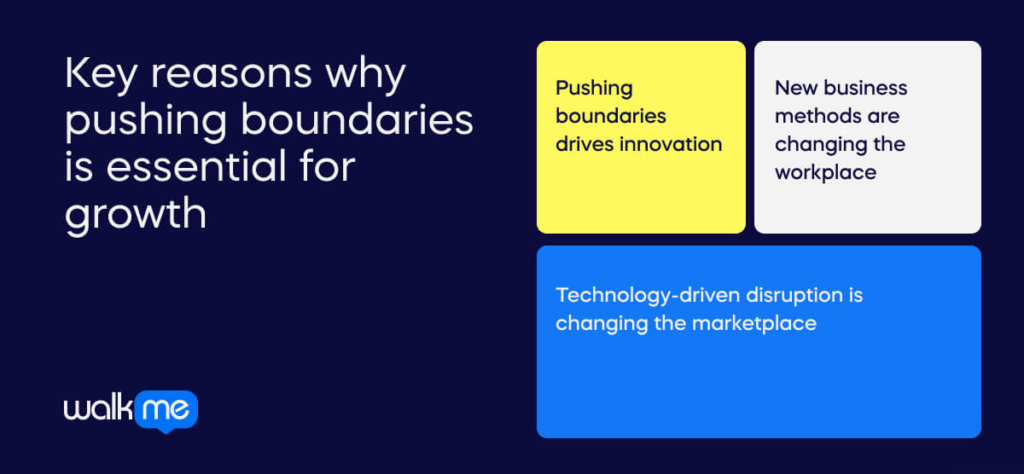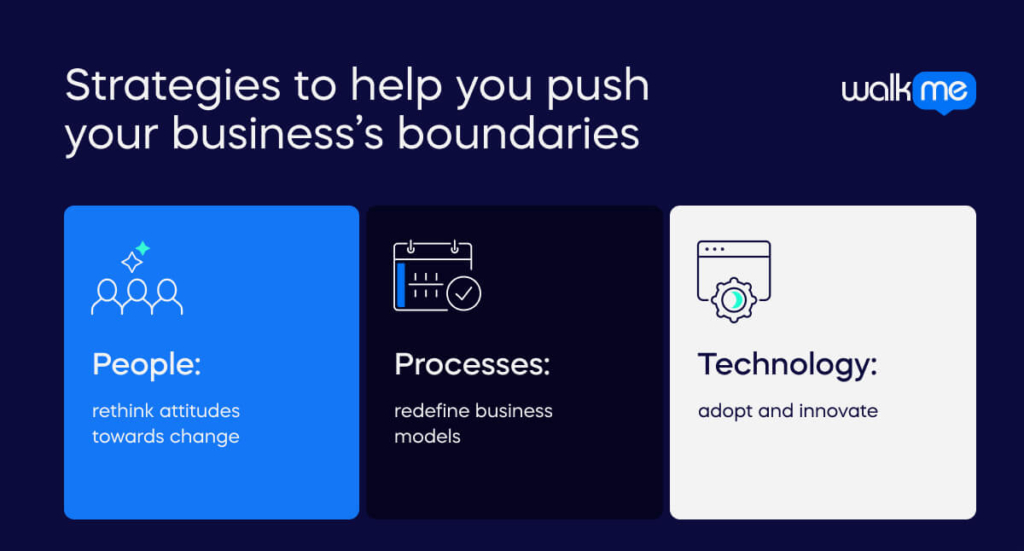The act of pushing boundaries is critical for sustaining competitiveness and driving innovation.
Your willingness to venture into uncharted territories can make the difference between leading the market and trailing behind competitors.
In this article, we’ll delve into the reasons why pushing boundaries is the key to innovation and growth in business, and we’ll offer practical strategies for extending your business beyond its current horizons.
By embracing a culture of risk-taking and continuous improvement, you can unlock new growth opportunities for your business and stay ahead of the curve.
Key reasons why pushing boundaries is essential for growth

Here are three big reasons why every employee and business needs to push boundaries in today’s economy:
1. Technology-driven disruption is changing the marketplace
Technology-driven disruption is changing the marketplace and many traditional industries are struggling to keep up.
A 2021 McKinsey survey found that 57% of businesses have adopted AI in some form. And of those adoptees, 47% are using AI for some form of data analytics.
The global digital transformation market is expected to grow to $1,009.8 billion by 2025 from $469.8 billion in 2020.
Those that have been the most successful typically fall into a few categories:
- Those willing to push their own boundaries
- Early adopters and innovators
- The early majority of technology adopters
On the other hand, some businesses fail to recognize when “the writing is on the wall” and can’t keep up with the rising tide of innovation.
One oft-touted example was when Amazon disrupted the offline retail world, which caused many existing industry leaders to fail completely.
COVID-19 represents another example, which forced many businesses to adapt or fall by the wayside – unsurprisingly, the most successful were those who were willing to rethink existing business models and practices.
2. New business methods are changing the workplace
Agile and lean business practices have become quite common in recent years since they are more suited to the digital-first world.
While many employees and businesses have embraced these new business practices, others have not. After all, they do represent change and change is uncomfortable.
Agile organizations, for instance, are built around principles such as:
- Collaboration
- Customer-driven service design
- Responsiveness and flexibility
In short, for many workers, these new modes of thinking require pushing beyond boundaries and enduring the discomfort that may come with that process.
3. Pushing boundaries drives innovation
Sometimes it’s necessary to push boundaries in order to really innovate.
If you never push the boundaries, then you’re never going to come up with anything truly innovative, because you’re going to be too scared to break away from the status quo.
All of today’s biggest tech companies— such as Google, Facebook, and Amazon— are examples of companies that have been willing to step outside the status quo in order to innovate and create new forms of value.
Strategies to help you push your business’s boundaries

Here are a few ways you can push your organization beyond its own boundaries and stay relevant in the post-COVID next normal.
1. People: rethink attitudes towards change
When change comes, some people embrace it and some people resist it.
Resistance to change can come in many forms:
- Some people fear that they will lose their jobs
- Some fear that they will be overwhelmed by new technology
- Some don’t feel like they have the proper training
- Some are just afraid of the unknown
Therefore, when asked to push beyond boundaries, it should come as no surprise that many employees resist change and cling to the status quo.
To help employees surpass these often unnecessary limitations, employers can take several strategies:
- Implement employee training programs
- Hire employees who are creative and innovative
- Cultivate a culture that is open to learning
- Invite participation from employees during organizational changes
The best approach is to assess one’s own organization, employees’ attitudes, and their fears, then develop a communication strategy based on that approach.
2. Processes: redefine business models
Business models should be redefined for the new economy. The future of business depends on how quickly you can adapt to change and how well you can shift from one business model to another.
As mentioned above, for instance, organizational agility is key to staying successful in the digital era.
It is important to note, however, that organizational agility depends on other factors, such as workforce agility, business practices, and organizational culture.
In addition to cultivating a culture of learning, as mentioned above, it is important to complement that shift with more modern business practices.
A few examples include:
- Agile product development and management
- Lean thinking
- Hybrid product development
- Rapid product innovation
These types of business practices, it should be noted, must go hand-in-hand with new business strategies and, as mentioned, new ways of thinking.
3. Technology: adopt and innovate
Adapting to new technology and innovating is the only way to stay relevant in any industry, including “traditional” industries such as manufacturing, energy, and agriculture.
There are a few reasons why:
- Digital disruption is fueling massive productivity gains in every sector
- Organizations that adapt early become leaders
- To engage with business partners and the economy, technology adoption is a must
Also, and perhaps most importantly, customer sentiment shifts minute by minute – and those attitude changes often follow in tandem with technology-driven innovations.
Organizations willing to adopt new technology early on, therefore, stand a better chance of keeping up with these shifts and leaving their competitors behind.
Pushing boundaries: Embracing change as the new constant in business
The drive to push boundaries is not just a desirable attribute but a necessary strategy for businesses aiming to thrive in an ever-changing, technology-driven world.
As we’ve explored, it’s necessary to innovate, adapt agile methodologies, and leverage technology.
It isn’t only about staying relevant – it’s about being a leader in your field. The examples of industry giants like Google, Amazon, and Facebook demonstrate that stepping beyond the comfort zone is where true innovation and market leadership are forged.
In essence, pushing boundaries means more than just adopting new technologies or business transformation; it’s about cultivating a mindset of continual growth, learning, and adaptation among your people. It’s about transforming the fear of the unknown into the excitement for what’s possible.
By rethinking attitudes towards change, redefining business models, and embracing technological advancements, you can not only navigate but also shape the evolving business landscape.
As the future of business continues to unfold in unexpected ways, particularly in the new normal era, the ability to push boundaries becomes the distinguishing factor between businesses that merely survive and those that thrive.
This journey requires a blend of courage, innovation, and foresight— qualities that are indispensable in the pursuit of growth and excellence.

